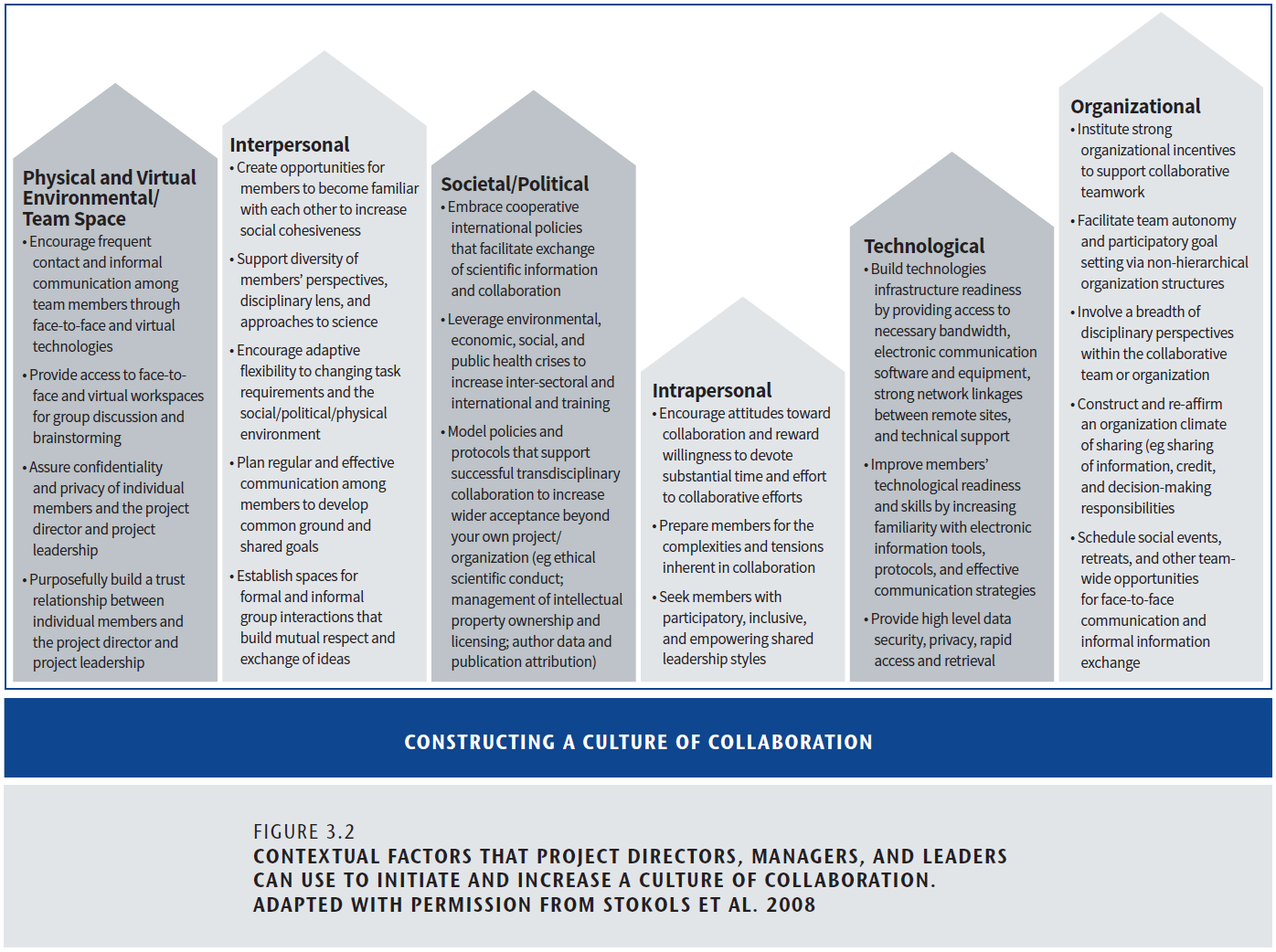Back to: Phase 2: Launching the Team
Design the space that allows individual work, collaboration plus awareness about what is going on
One of the essential pillars of collaboration is the configuration of space and people so that they are able to do all aspects of collaboration:

The above is from page 23 of Eigenbrode, S. D., Martin, T., Wright Morton, L., Colletti, J., Goodwin, P., Gustafson, R., Hawthorne, D., Johnson, A., Klien, J. T., Pearl. S., Richard, T., and Wolcott, M. (2017) Leading large transdisciplinary projects addressing social-ecological systems: A primer for project directors.
The goal is to create space where people have:
- Uninterrupted, quiet space to focus on the tasks at hand
- Private space to conduct phone calls or private meetings (e.g. for personal feedback)
- Spaces for meetings with technical support for screen sharing and bringing in others by video
- Space for informal discussion, e.g. around a coffee machine, the printer
- Spaces where people can casually bump into each other (noting that they are not “heads down” not to be interrupted). Halls and where various facilities are placed (e.g. restrooms) are key.
- Awareness of what others are doing, especially where they are having difficulty with a subtask for which others might help.
- Shared facilities, e.g. special lab equipment
- With daylight to penetrate to ground people in their environment
Often a designer of space has to balance the need for space for “heads down” work and the need for bumping into each other for collaboration and awareness of what others are doing. In one key study at Ford Motor Company, our observations of people put in team rooms instead of offices and assigned only one project at a time showed that awareness and spontaneous helping were key to the surprising doubling of productivity shown by all six teams in the study (Teasley et al, 2002).
A more technical approach is to use a method from Architecture called Space Syntax (Wineman, et al, 2009, 2014). Space syntax calculates a number of things about a person’s office and the distance to other people’s offices, the traffic volume on each hall, and the time spent in a spot where people convene, like the printer or coffee machine. High traffic, low distance, and time spent with others different from you at a gathering spot were associated with high innovation, but not necessarily getting that innovation to market. Having people around you who are like you is associated with being able to take the innovation and getting it to work, either to those who need it or to market. It is important to distinguish the two phases of innovation and productivity. Presumably, the software development teams in Ford Motor Company were of the second sort, where being with similar others was very effective. Coming up with what the software could do, however, might be associated with mixing people in the halls (e.g., with offices of different kinds of people near each other) or having them talk at the convening point.
J.S. Olson, based on the references, below.
References:
- Teasley, S., Covi, L., Krishnan, M. S., and Olson, J. S. (2002) Rapid Software Development through Team Collocation, IEEE Transaction on Software Engineering, 28(7), 671-683.
- Wineman, J. D., Kabo, F. W., and Davis, G. F. (2009) Spatial and social networks in organizational innovation. Environment and Behavior, 41(3) 427-442.
- Wineman, J. D., Hwang, Y., Kabo, F., Owen-Smith, J., and Davis, G. F. (2014) Spatial layout, social structure, and innovation in organizations. Environment and Planning and Design. 41, 110-112.
